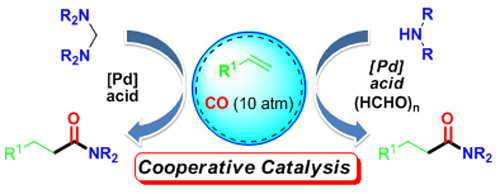Transitional metal catalyzed hydroaminocarbonylation of alkenes is an important method to synthesize amides. However, only a few catalytic systems dealing with hydroaminocarbonylation of alkenes have been reported. This is mainly because that the effective catalytic reactor in this catalytic system is triggered by [M-H] which can only be formed under relatively acid condition. But aliphatic amines which are more basic may inhibit the generation of [M-H], thus preventing the N-alkylsubstituted amides from being formed.
Therefore, the development of solutions to overcome the inherent side effect incurred by the strong basicity of aliphatic amines would be highly desirable to increase the range of amides which may be accessed.
The research group headed by Prof. HUANG Hanmin at the Lanzhou Institute of Chemical Physics (LICP) of the Chinese Academy of Sciences (CAS) has developed a new and efficient protocol for the successful implementation of the palladium-catalyzed hydroaminocarbonylation of alkenes with a variety of aminals by C-N bond cleavage, and it allows synthesis of a variety of N-alkylsubstituted amides under mild reaction conditions.
Based on their progress on the use of aminals as electrophiles for palladium-catalyzed coupling reactions and aminals’ reaction with a copper complex to generate a copper amide species by C-N bond cleavage under mild reaction conditions, they postulated that the palladium hydride species might be generated in the presence of a catalytic amount of acid and aminal since the basicity of the aminal is lower, and would allow subsequent migratory insertion of the alkene and CO into the palladium hydride species to generate the acyl palladium species A. The interaction of A with an aminal would allow generation of the key intermediate B together with the iminium C through C-N bond cleavage. The iminium C would quickly react with another molecule of A, facilitated by water, to afford the second molecule of B together with paraformaldehyde and acid (HX). Reductive elimination of B leads to the final hydroaminocarbonylation products.
To validate their hypothesis, the hydroaminocarbonylation reaction was initially investigated with styrene and aminal in the presence of a catalytic amount of Pd(TFA)2, acid, and H2O (0.55 equiv) under 10 atm of CO in anisole at 120℃. The results show that two amino moieties of the aminal were successfully incorporated into the desired amide, thus suggesting that their strategy is feasible.

On the basis of the above method, researchers established a cooperative catalytic system through the synergistic combination of palladium, paraformaldehyde, and acid for promoting the hydroaminocarbonylation of alkenes with both aliphatic and aromatic amines.
This study not only provides an efficient method to realize the hydroaminocarbonylation with both aliphatic and aromatic amines under mild reaction conditions, but also paves the way for establishing new C-N bondformation reactions by using this cooperative catalysis. Studies aimed at gaining a detailed mechanistic understanding of this reaction and the application of this strategy in other reactions are currently in progress.
The work has received support from the National Natural Science Foundation of China and the “135” Planning of LICP.
The findings have been published in Angew. Chem. Int. Ed.2015, 54, 7657 –7661.
Contact:
HUANG Hanmin
State Key Laboratory for Oxo Synthesis and Selective Oxidation, Lanzhou Institute of Chemical Physics, Chinese Academy of Sciences
Lanzhou, 730000 (China)
E-mail: hmhuang@licp.cas.cn


